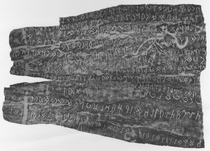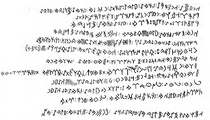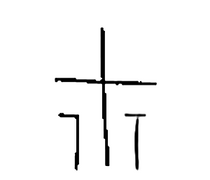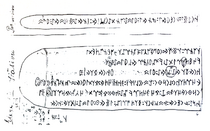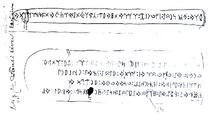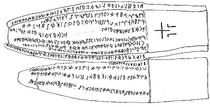| Data sheet
|
| Identifier
|
Tyva 2
|
| Alternative names
|
E-10, Körtle Khan inscription, Elegest of Ulug Khem
|
| Place of origin
|
Republic of Tyva, Russia
|
| Date
|
Unknown
|
| GPS Coordinates
|
No exact coordinates available
|
| Current location
|
Minusinsk Martyanov Museum
|
| Curator's URL
|
http://музей-мартьянова.рф
|
| Material
|
Stone
|
| Tamga
|
Tamga1
|
| Historical affiliation
|
Enisei Kyrgyz
|
| Deciphered
|
Yes
|
| 3D representation
|
No
|
| Map
|
Loading map... {"minzoom":false,"maxzoom":false,"mappingservice":"leaflet","width":"auto","height":"350px","centre":false,"title":"","label":"","icon":"","lines":[],"polygons":[],"circles":[],"rectangles":[],"copycoords":false,"static":false,"zoom":6,"defzoom":14,"layers":["OpenStreetMap"],"image layers":[],"overlays":[],"resizable":false,"fullscreen":false,"scrollwheelzoom":true,"cluster":false,"clustermaxzoom":20,"clusterzoomonclick":true,"clustermaxradius":80,"clusterspiderfy":true,"geojson":"","clicktarget":"","imageLayers":[],"locations":[{"text":"","title":"","link":"","lat":51.51,"lon":94.12,"icon":""}],"imageoverlays":null} |
The inscription was found by Aspelin in 1888 on the left bank of the river Elegest, about seven kilometres far from its influx. The stone was transported to the Minusinsk Martyanov Museum in 1915 and catalogued under No. 19. It measures 320 x 66 x 20 centimetres.
Editions
Radloff (1895, 311-314), Orkun (1940, 179-183), Малов (1952, 25-28), Васильев (1983, 18, 60, 88-89), Aalto (1991, 35-37), Кормушин (1997, 228-242), Базылхан (2005, 177, 329), Кормушин (2008, 100-102), Yıldırım, Aydın and Alimov (2013, 40-44), Aydın (2015, 51-55), Kormuşin, Mozioğlu, Alimov and Yıldırım (2016, 68-72), Aydın (2019, 64-69)
Transliteration
- KWYDA : KWnǰYmA : szmA : YIṬA : ẄzdA WGLm : szmA : DRLṬmA : YIṬA
- yẄzr : KDšm WYRN : Ẅčn : yẄzrn : lg : Ẅkzn : tkdI ...
- kẄẅktŋrIdA : kẄnYszrmš : YIṬA : szmA : DRLṬmA
- KNm : elmA : szmA : YIṬA ... bẅkmdm : KNmelmA : YIṬA : DRLṬm
- kẄrtlKN : LWRŊWLṬWNLG: ks : gnn ... bldA ... : ṬWKzskzWn : YšDA
- WrŊWkẄlg : ṬwK : bẄgẄtrknA : KŊm : bg : rdm : Ẅčn : b ...
- KRA : BWDNm : KṬGLNŊ eltẄrsn : IDmŊ : YIṬA : sz : lm : KNm
- elmWGRNṬA : sẄ : BWLp : rlrmdẅkmYwK : čblgdA : brtgmdA : skz : r : lrdm
- elmWṬšŋAbIrKILNW ...
- BWŊ : BŊA : BnBṬrms : Ẅldm : YIṬA : szmA : YLQnYnA
- tẄrtDK : YILKm : skzDK : LG : BRmm : BWŊm : YWwK : rdm
- KDšmA : kenmA : DRLṬmA : YIṬA : KRA : BWDNmA : DRLṬm : YIṬA : mn
Transcription
- quyda[1] qunǰuyïm a äsizim a[2] ayït a[3] özdä oɣlïm äsizim a adrïltïm a ayït a
- yüz är qadašïm uyurïn üčün yüz ärin älig öküzin ...
- kök täŋridä kün ay äsiz ärmiš ayït a äsizim a adrïltïm a
- qanïm elim a äsizim a ayït a ... bökmädim qanïm elim a ayït a adrïltïm
- körtlä qan[4] al uruŋu altunlïɣ käšig ... bäldä ... toquz säkiz on yašda
- uruŋu külig toq bögü tärkän a qaŋïm bäg ärdäm üčün ...
- qara bodunïm qatïɣlanïŋ el törösin ïdmaŋ ayït a äsiz älim qanïm
- elim uɣrïnta sü bolïp ...[5] yoq ... säkiz är ...
- elim ...
- buŋ baŋa ... bat ärmiš öldim ayït a äsizim a ...
- tört adaq yïlqïm säkiz adaqlïɣ barïmïm[6] buŋïm yoq ärdim
- qadašïm a äkenim a adrïltïm a ayïta qara bodunïm a adrïltïm ayït a män
Translation
- O my consort in the secluded place! O my sorrow! May thou say! O my son in the valley! O my sorrow! O, I departed. May thou say!
- Because of the capability of my hundred kinsmen ... with hundred kinsmen and fifty oxen.
- Both the Sun and the Moon in the blue sky were weighed down in sorrow. May thou say! O my sorrow! O, I departed.
- O my khan, o my realm! O my sorrow! May thou say! ... I did not get fully satiated. My khan, my realm! May thou say sorrow! I departed.
- [I am] Körtlä khan, the Al Uruŋu. ... a golden quiver ... round my waist. I was seventy nine.
- O Uruŋu Külig Tok Bögü Tärkän! Because of the merit of my father, the beg ...
- Exert yourself my common people! Do not repudiate the unwritten law of the realm! May thou say, my sorrowful people and khan!
- My realm set up an army in the right time ... eight men ...
- My realm ...
- The grief was ... to me. I died. May thou say, o my sorrow! ...
- My four legged livestock, my eight legged properties. I did not get grief.
- O my kinsmen, o my progeny! I departed. May thou say! O my common people! I departed. May thou say!
- ↑ We interpret the words quy and öz as two different parts of a valley: a secluded, protected part and a central, open one, respectively.
- ↑ Tekin (1964) pointed out that the runiform letters ⟨sIz⟩ are to be read as äsiz 'alas'.
- ↑ The runiform letters ⟨YITA⟩ are read as ayït a, that is the second person imperative of the verb ayït- 'to say' with interjection.
- ↑ The letters ⟨kẄrtlKN⟩ are interpreted by Tekin (1995, 20), Кормушин (1997, 236-237; 2008, 101) and Sertkaya (2017) as körtlä qan. Since the final vowel of körtlä is not written, it is either a mistake in the inscription or the two words were handled by the author as one unit, i.e. a compound. See the inscription Elegest II with plene writing of the vowel in ⟨kẄrtlA⟩ körtlä. Cf. the word körtlä 'beautiful' appearing in other Old Turkic sources. The interpretations kürt el kan by Orkun (1940, 180) and kört äl kan by Malov (1952, 26) are unlikely.
- ↑ The runiform letters ⟨rlrmdẅkmYwK⟩ are interpreted by Sertkaya (1995, 739) as er ölürmedüküm yok '(düşman askeri) öldürdüm' and (2010, 211-212) är ölürmädükim 'er (savaşçı) öldürmediğim', whereas Кормушин (2008, 101) reads ärlärmädükim joq 'ja (lichno) ne porazhal voinov (vraga)'. Since neither is convincing, we leave this passage for the time being uninterpreted.
- ↑ The phrase säkiz adaqlïɣ barïm most likely describes properties or belongings of the pastoral nomads pulled by four legged draught animals on four wheeled carts, hence the number eight.
Grapheme inventory
Pictures and drawings
References
Aalto, Pentti 1991.
‘Old Turkic epigraphic materials (Gathered by J. G. Granö)’, Journal de la Société Finno Ougrienne 83: 7–78.
EniseiAalto1991EnglishLatin
Aspelin, Johann Reinhold, Donner, Otto 1889. Inscriptions de l'Iénissei: recueillies et publiées par la Société finlandaise d'archeologie. Helsingfors:
Imprimerie de la Société de littérature finnoise.
EniseiAspelinDonner1889FrenchLatin
Aydın, Erhan 2015. Yenisey Yazıtları. Konya:
Kömen Yayınları.
EniseiAydın2015TurkishLatin
Kormuşin, İgor, Mozioğlu, Emine, Alimov, Risbek, Yıldırım, Fikret 2016. Yenisey - Altay - Kırgızistan Yazıtları ve Kâǧıda Yazılı Runik Belgeler. Ankara:
BilgeSu.
Еnisei, Talas, TurkestanKormuşinMozioğluAlimovYıldırım2016TurkishLatin
Orkun, Hüseyin Namık 1940. Eski Türk Yazıtları, 3. İstanbul:
Devlet Basımevi.
YeniseiOrkun1940TurkishLatin
Radloff, Wilhelm 1895. Die alttürkischen Inschriften der Mongolei. St. Petersburg:
Buchdruckerei der Kaiserlichen Akademie der Wissenschaften.
Yenisei, OrkhonRadloff1895GermanLatin
Sertkaya, Osman Fikri 1995.
‘Göktürk Tarihinin Meseleleri: Yenisey Yazıtlarının Yayınlarındaki Bazı Okuma ve Anlamlandırmaların Düzeltilmesi, Yeni Okuma ve Anlamlandırma Teklifleri’, Türk Dili Araştırmaları Yıllığı-Belleten 1993: 67–75.
EniseiSertkaya1995TurkishLatin
Sertkaya, Osman Fikri 2010.
‘Yenisey yazıtlarından 10, 25, 41, 51, 70, 109 ve 110 üzerine etimolojik açıklamalar ile düzeltmeler’, in Alyılmaz, Cengiz, Ay, Özgür, Yılmaz, Metin (eds) I. Uluslararası Uzak Asya'dan Ön Asya'ya Eski Türkçe Bilgi Şöleni Bildirileri (18-20 Kasım 2009, Afyonkarahisar/Türkiye), pp. 210-228. Afyonkarahisar: Afyon Kocatepe Üniversitesi (Afyon Kocatepe Üniversitesi Yayınları, 80).
EniseiSertkaya2010TurkishLatin
Sertkaya, Osman Fikri 2017.
‘Yenisey Yazıtlarından E-10’da KẄRTL, E-52’de İse KẄRTLA Şeklinde Geçen Kelimeyi ‘Kür(ü)t(ü)l’ mü Yoksa ‘Körtle’ mi Okumalıyız?’, Journal of Old Turkic Studies 1: 113–127.
EniseiSertkaya2017TurkishLatin
Tekin, Talat 1964.
‘On a misinterpreted word in the Old Turkic inscriptions’, Ural-Altaische Jahrbücher 35: 134–144.
Enisei, Orkhon, TalasTekin1964EnglishLatin
Tekin, Talat 1995.
‘Elegest (Körtle Han) Yazıtı’, Türk Dilleri Araştırmaları 5: 19–32.
EniseiTekin1995TurkishLatin
Thomsen, Vilhelm 1916. Turcica. Études concernant l'interprétation des inscriptions turques de la Mongolie et de la Sibérie. Helsingfors:
Société Finno-Ougrienne (Mémoires de la Société Finno-Ougrienne, 37).
Orkhon, EniseiThomsen1916FrenchLatin
Yıldırım, Fikret, Aydın, Erhan, Alimov, Risbek 2013. Yenisey - Kırgızistan Yazıtları ve Irk Bitig. Ankara:
BilgeSu.
Yenisei, Talas, TurkestanYıldırımAydınAlimov2013TurkishLatin
Базылхан, Нәпіл (ed.) 2005. Қазақстан тарихы туралы түркі деректемелері, 2: Көне түрік бітіктастары мен ескерткіштері (Орхон, Енисей, Талас). Алматы:
Даук-Пресс.
Enisei, Talas, OrkhonБазылхан2005KazakCyrillic
Васильев, Дмитрий Дмитриевич 1983. Корпус тюркских рунических памятников бассейна Енисея. Ленинград:
Наука.
EniseiВасильев1983RussianCyrillic
Кормушин, Игорь Валентинович 1997. Тюркские енисейские эпитафии: Тексты и исследования. Москва:
Наука.
EniseiКормушин1997RussianCyrillic
Кормушин, Игорь Валентинович 2008. Тюркские енисейские эпитафии: Грамматика, текстология. Москва:
Наука.
EniseiКормушин2008RussianCyrillic
Малов, Сергей Ефимович 1952. Енисейская письменность тюрков: Тексты и переводы. Москва, Ленинград:
Наука.
EniseiМалов1952RussianCyrillic
Радлов, Василий Васильевич 1893. Атлас древностей Монголии, 2. Санктпетербург:
Наука.
Enisei, OrkhonРадлов1893RussianCyrillic
Щербак, Александр Михайлович 1970.
‘Енисейские рунические надписи: К истории открытия и изучения’, Тюркологический сборник 1970: 111–134.
EniseiЩербак1970RussianCyrillic
Authorship
Károly, László 2023, 20 November. ‘Elegest I’, in László Károly, Julian Rentzsch (eds) A Database of Turkic Runiform Inscriptions, Uppsala: Department of Linguistics and Philology. URL: https://www.runiform.lingfil.uu.se/wiki/Elegest I (accessed 05 Dec 2025)








































